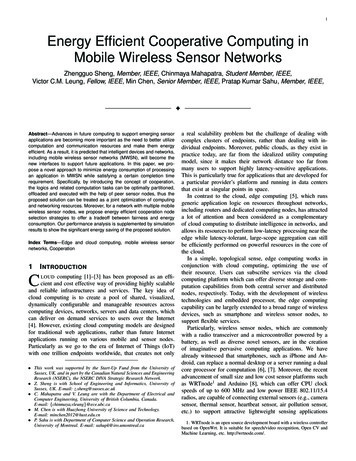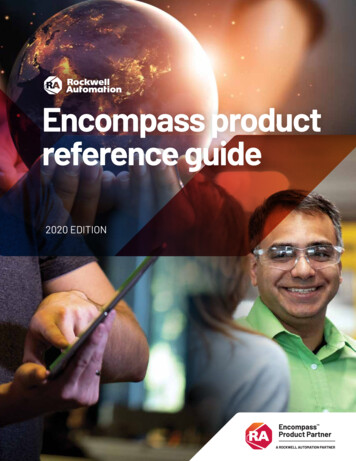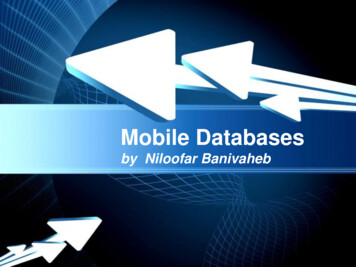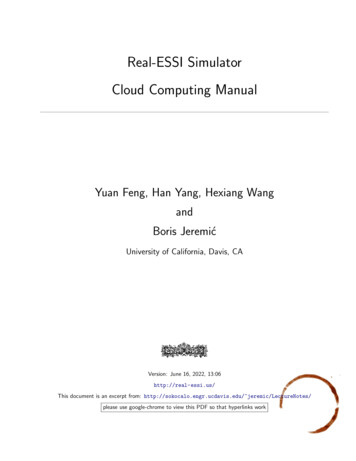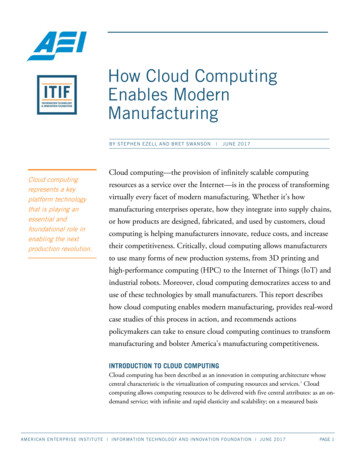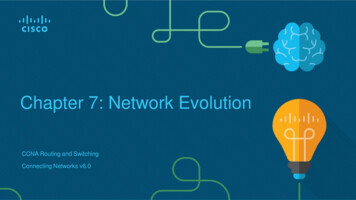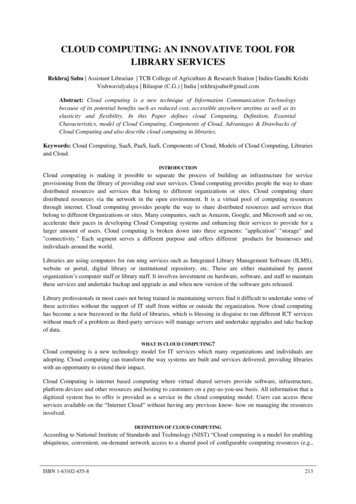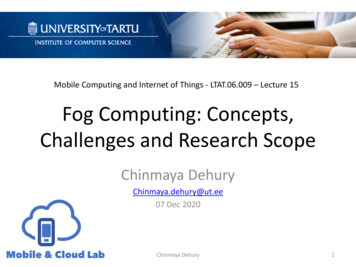
Transcription
Mobile Computing and Internet of Things - LTAT.06.009 – Lecture 15Fog Computing: Concepts,Challenges and Research ScopeChinmaya DehuryChinmaya.dehury@ut.ee07 Dec 2020Chinmaya Dehury1
Outline Fog computingFog computing challengesFog placement strategiesFuture research directions07/12/2020Chinmaya Dehury2
Layers of Cloud-centric IoTRemote Cloud-basedprocessingProxy StorageProcessingConnectivity nodes &Embedded processingSensing and smart devices07/12/2020Chinmaya Dehury3
Issues with Cloud-centric IoT The cost of a cloud-only solution is too high– To run a large scale IoT system with 1000 geo-distributeddevices [FogFlow] Latency issues for applications with sub-second responserequirements– Health care scenarios– Smart cities and tasks such as surveillance need real-timeanalysis with strict deadlines– Many IoT services require 10ms end-to-end latencyProxy StorageProcessing Network load Certain scenarios do not let the data move to cloud– Better security and deeper insights with privacy control07/12/2020Chinmaya Dehury4
Fog ArchitectureLarge-scale distributeddata analyticsCloude.g. MapReduce, Flink, SparkEdge AnalyticsFiltering, consolidation, errordetection, anonymizationCore NetworkFog NodesPrivate Clouds, Cisco IOx,Switches, CloudletsGatewaysFogAccess points, Mobile Phones,Single Board Computers, CPEEdge NodesSensors, Actuators, MobilePhones, Smart Vehicles, 07/12/2020Chinmaya Dehury5
Fog Computing Processing across all the layers, includingnetwork switches/routers[Chang et al, AINA 2017; FEC 2019; Mass et al, SCC 2016; Liyanage et al, PDCAT 2016]07/12/2020Chinmaya Dehury6
Fog applications Multi-media applications– Finding best data streaming bit rate in different scenarios Such as in video surveillance applications– Adjusting video encoding rate (video processing speed) based onnetwork load Sensor data filtering and preprocessingSensing frequency calibrationSensor data predictionInteractive games– Electroencephalogram(EEG) Tractor Beam game– Real-time EEG signal analysisand brain state (concentration)prediction[Zao et al, Frontiers in Human Neuroscience 8:370]07/12/2020Chinmaya Dehury7
Types of fog computing applications Top-down applications– Applications that are managed by a cloud provider– Cloud provider deploys the necessary geo-distributed resources– Cloud providers manage the IoT application execution across thefog topology– Consider proximity and QoS parameters such as user load,latency, cost models etc. Bottom up applications– Applications that are managed by individual service providers– Fog resources are provided by different vendors E.g. General public, private clouds, network operators– Gateways decide how to schedule the components across thefog topology [Dehury et al, iiWas2019; Dehury et al, ccgrid2020]07/12/2020Chinmaya Dehury8
Advantages of Fog Computing Security– Supports additional security to IoT devices to ensure safety and trustworthiness in transactions Cognition– Enables fog providers the awareness of the objectives of their clients towardsupporting autonomous decision-making E.g. where and when to deploy computing, storage, and control functions Agility– Brings the opportunity to individual and small businesses to participate inproviding FEC services Latency– Provide rapid responses for the applications that require ultra-low latency Efficiency– Reduces the unnecessary cost of outgoing communication bandwidth– Consume minimum power for data offloading and processing when comparedto CIoT model[Chang et al, FEC 2019; Dehury et al, iiWas2019; Dehury et al, ccgrid2020]07/12/2020Chinmaya Dehury9
Research Challenges in Fog Computing Frameworks for establishing fog setups Fog resource provisioning Dynamic fog computing service discovery andaccessing Fog execution frameworks Fog application placement07/12/2020Chinmaya Dehury11
Research Challenges in Fog Computing Mobility of fog devicesMulti-Fog environmentPrivacySecurityAuthentication and Trust Issues07/12/2020Chinmaya Dehury12
Quality of Service (QoS) vs Experience(QoE) QoS - refers to the overall features of system services which help tomeet the stated and implied needs of the end users [ITU]– QoS drives through an agreement between user and provider thatstrongly monitors technical attributes of system services– Cost, service delivery deadline, packet loss ratio, jitter, throughput,etc.– E.g. Downloading a particular file in max 5 min time QoE is the total acceptability of a service that is determined bysubjective perception of the end users [ITU]– Encapsulates user’s requirement, intentions and perceptions whileprovisioning system services– E.g. 2 users require that file in 3 min and 7 min respectively End users perceived QoE can degrade the acceptability of a servicegreatly even when the proper QoS is maintainedITU - International Telecommunication Union07/12/2020Chinmaya Dehury13
IndieFog Indie Fog [Chang et al, IEEE Computer 2017]– System architecture for enabling fog computing withcustomer premise equipment Proactive fog computing using resource-aware workstealing [Soo et al, IJMCMC 2017] Dynamic fog computing service discovery andaccessing07/12/2020Chinmaya Dehury14
Fog application placement strategies Resource intensive tasks of IoT applications can be placedacross the Fog topology How to decide to which node the task to be offloaded?– Based on quality of service (QoS) parameters such as latency,resources, cost etc.– Latency and cost-aware [Mahmud et al, JPDC 2020] application modulemanagement The problem can also be formulated as multi-objectiveoffloading strategy [Adhikari et al, IEEE IoTJ 2020]––––Latency and resource managementNeed to consider the types of the jobs and their priorityNeed to find ideal heuristics, metaheuristics etc.Also have to consider the graph topology of the Fog nodesQoS – Quality of ServiceQoE 07/12/2020– Quality of ExperienceChinmaya Dehury18
Quality of Experience (QoE)-aware Placement ofApplications in Fog Computing Environments Fuzzy logic based approach thatprioritizes different applicationplacement requests– Based on the user expectations(Rating of Expectation) Fuzzy logic based approach thatclassifies Fog computationalinstances– Based on current status of theinstances (Capacity Class Score) A linearly optimized mapping ofapplication placement requests toFog computing instances– To ensure maximized QoE-gain ofthe user[Mahmud et al, JPDC 2019]07/12/2020Chinmaya Dehury22
DPTO: A Deadline and Priority-aware TaskOffloading in Fog Computing FrameworkLeveraging Multi-level Feedback Queueing Task Priority 1:– Class that supports the delaysensitive tasks with harddeadlines– No negotiation on deadline Task Priority 2:– Tasks have intermediate prioritywith soft-deadline– Tasks meet their deadline with anegotiation and penalty Task Priority 3:– Lowest priority class that aims tosupport the resource-intensivetasks– No deadline– Mostly offloaded to the cloud[Adhikari et al, IEEE IoTJ 2020] Goal: To minimize the overall queueing waiting time and offloading timeof the real-time tasks while meeting the deadline and resource07/12/2020Chinmaya Dehury27
Service dispersal mechanism for fogand cloud computing Service is delivered by both fog andcloud Service Slicing What percentage of a service should bedelivered by fog and by cloud ? Parameters–––––Service LatencyResource demand fulfilled by fogComputation latencyUser’s distanceUser’s priority[Dehury et al, iiWas2019; Dehury et al, ccgrid2020]07/12/2020Chinmaya Dehury29
Service dispersal mechanism for fogand cloud computing Multi fog environment Use of AI tool to efficientlydistribute the slices amongfog nodes and cloud Challenges:– Experimenting in multi-fogenvironment– incorporating serverlessenvironment[Dehury et al, iiWas2019; Dehury et al, ccgrid2020]07/12/2020Chinmaya Dehury30
HeRAFC: Heuristic Resource Allocation andOptimization in MultiFog-Cloud Environment(a) Abstract view of MultiFog-Cloud (MFC) environment. (b) An example of user’s application (in DAG form).The infrastructure and applications are modelled using graph theoryFCI (Fog-Cloud Interface) is introduced, where a fog node can communicate withcloud and other fog nodes as wellA task can be assigned to other fog nodes at multi-hop distanceHeuristic approach is followed to achieve the objective of resource utilizationmaximization[Dehury and Srirama, TSC 2020 (Under review)]07/12/2020Chinmaya Dehury31
Fog Computing – Research Challenges- continued Process-driven Edge Computing in Mobile IoT[Mass et al, IoTJ 2019; CASA 2018; Chang et al, CSUR 2016]07/12/2020Chinmaya Dehury32
Fog Computing – Research Challenges- continued Mobility also becomes critical in Fog computing [Mass et al, IoTJ 2019] STEP-ONE : Simulated Testbed for Edge Processes based on theOpportunistic Network Emulator [Mass et al, JSS 2020 (under review)]– Extended the ONE simulator to simulate the Fog computing mobility aspects– Process execution based on Flowable BPMS07/12/2020Chinmaya Dehury33
STEP-ONE07/12/2020Chinmaya Dehury34
Future Research Scope Standards-based dynamic deployment and management of fogapplications– Deployment should consider heterogeneity, mobility aspects, multipleownership (interoperability) etc.– Cloud computing community addressed similar problem through OASIS TOSCA– Extending TOSCA to support fog-based applications– Develop relevant orchestrators Efficient algorithms for self-adaptive resource provisioning and QoS-awareapplication module scheduling in fog topology Reliable and data-locality preserving real-time data processing in fogenvironments [Dehury et al, FGCS 2020; Dehury et al, ECSA 2020]– Controlling the dataflow of distributed data processing applications across themulti-layer fog– Restructure the IoT applications into dynamically composable multi-stage datapipelines– Actor programming model and serverless functions edge analytics tasks– Apache Nifi data pipelines for task composition IoT case studies in domains such as smart city, smart healthcare, smartagriculture etc.07/12/2020Chinmaya DehuryTOSCA - Topology and Orchestration Specification for Cloud Applications35
07/12/2020Chinmaya Dehury37
References1.2.3.4.5.6.7.8.9.10.11.12.13.Fog and Edge Computing: Principles and Paradigms, Editors: R. Buyya and S.N. Srirama, Wiley, 2019. ISBN: 978-1-119-52498-4C. Chang, S. N. Srirama, R. Buyya: Internet of Things (IoT) and New Computing Paradigms, Book title: Fog and Edge Computing:Principles and Paradigms, Editors: R. Buyya and S.N. Srirama, ISBN: 978-1-119-52498-4, Wiley, 2019, pp. 3-23.C. Chang, S. N. Srirama, R. Buyya: Indie Fog: An Efficient Fog-Computing Infrastructure for the Internet of Things, IEEE Computer,ISSN: 0018-9162, 50(9):92-98, 2017. IEEE.S. Soo, C. Chang, S. Loke, S. N. Srirama: Proactive Mobile Fog Computing using Work Stealing: Data Processing at the Edge,International Journal of Mobile Computing and Multimedia Communications (IJMCMC), ISSN: 1937-9412, 8(4):1-19, 2017. IGI Global.R. Mahmud, S. N. Srirama, R. Kotagiri, R. Buyya: Quality of Experience (QoE)-aware Placement of Applications in Fog ComputingEnvironments, Journal of Parallel and Distributed Computing, ISSN: 0743-7315, 132:190-203, 2019. Elsevier.R. Mahmud, S. N. Srirama, R. Kotagiri, R. Buyya: Profit-aware Application Placement for Integrated Fog-Cloud Environments, Journalof Parallel and Distributed Computing, ISSN: 0743-7315, 135:177-190, 2020. Elsevier.M. Adhikari, M. Mukherjee, S. N. Srirama: DPTO: A Deadline and Priority-aware Task Offloading in Fog Computing FrameworkLeveraging Multi-level Feedback Queueing, IEEE Internet of Things Journal, ISSN: 2327-4662. IEEE. DOI: 10.1109/JIOT.2019.2946426(In print)J. Mass, C. Chang, S. N. Srirama: Edge Process Management: A Case Study on Adaptive Task Scheduling in Mobile Internet of Things,Internet of Things Journal, ISSN: 2542-6605, 6:100051, 17 pages, 2019. Elsevier.C. Chang, S. N. Srirama, R. Buyya: Mobile Cloud Business Process Management System for the Internet of Things: A Survey, ACMComputing Surveys (CSUR), ISSN: 0360-0300, 49(4):Article 70, 2016. ACM.C. K. Dehury and S. N. Srirama, "Personalized Service Delivery using Reinforcement Learning in Fog and Cloud Environment", The21st International Conference on Information Integration and Web-based Applications & Services (iiWAS2019), pp. 524-531, 2019.C. K. Dehury and S. N. Srirama; “An efficient service dispersal mechanism for fog and cloud computing using deep reinforcementlearning”; The 20th IEEE/ACM International Symposium on Cluster, Cloud and Internet Computing (CCGRID2020), 11-14 May 2020,Melbourne, Australia, Electronic ISBN: 978-1-7281-6095-5.C. K. Dehury and S. N. Srirama, T. R. Chhetri, "CCoDaMiC: A Framework for Coherent Coordination of Data Migration andComputation Platforms". Future Generation Computer Systems, Vol. 109, pp. 1-16, Aug 2020.Chinmaya Dehury*, Pelle Jakovits, Satish Narayana Srirama, Vasilis Tountopoulos, Giorgos Giotis; "Data Pipeline Architecture forServerless Platform", European Conference on Software Architecture, 2020, pp. 241-246, Springer07/12/2020Chinmaya Dehury38
The infrastructure and applications are modelled using graph theory FCI (Fog-Cloud Interface) is introduced, where a fog node can communicate with cloud and other fog nodes as well A task can be assigned to other fog nodes at multi-hop distance Heuristic approach is followed to achieve the objective of resource utilization .




